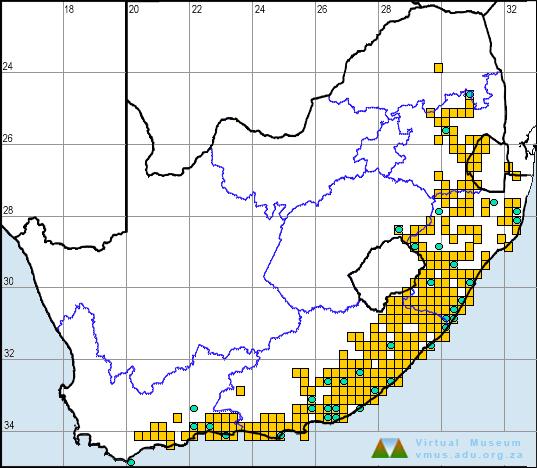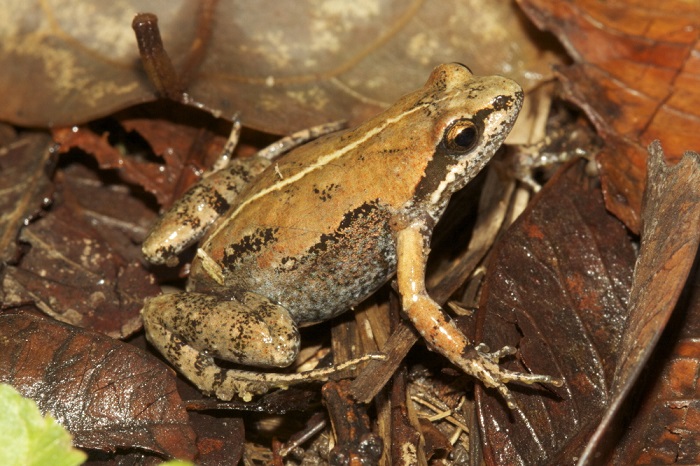View the above photo record (by Jean-Paul Brouard) in FrogMAP here.
Find the Bronze Caco in the FBIS database (Freshwater Biodiversity Information System) here.
Family Pyxicephalidae
BRONZE CACO – Cacosternum nanum
Boulenger, 1887
Habitat
C. n. nanum inhabits a wide variety of vegetation types in the Fynbos, Savanna, Grassland, Thicket and Forest biomes, occurring in areas of relatively high rainfall (Van Dijk 1971b). Breeding sites include small ponds, dams, vleis, streams, rain pools alongside roads, inundated grass and pasture.
Behaviour
During dry periods these frogs aestivate below the surface, sometimes emerging in large numbers after heavy rain (Wager 1965).
In KwaZulu-Natal, C. n. nanum commences breeding slightly earlier in the rainy season than C. boettgeri. Males call mainly from sheltered sites in deeper water. Calling males are distinctly territorial, loudly warning encroaching males by means of a territorial call that differs from their typical advertisement call. On warm, drizzly days or after rain, they may begin calling in the mid-morning, although they usually commence in the late afternoon and continue well into the evening.
Eggs are laid in clusters of 8–25, sometimes up to 50 (Wager 1986). As is typical of the genus as a whole, the eggs are anchored to the substrate. Wager (1986) reported that metamorphosed froglets of C. nanum leave the water 17 days after hatching, which may be the quickest growth to metamorphosis known in any frog (Duellman and Trueb 1986).
C. nanum has been reported to feed on mosquitoes in captivity (Wager 1965), and the species probably plays an important role in the control of small insects in undisturbed habitats. Predators have not been recorded.
Status and Conservation
C. n. nanum is one of the most common frogs in its range and, in the wet season, it can be heard calling from almost every rut, drainage ditch and small pond. It is known from many protected areas and is not threatened.
Distribution
Cacosternum nanum currently contains two subspecies: C. n. nanum and C. n. parvum (Poynton 1963; Lambiris 1989a). However, research in progress has produced morphological, behavioural and genetic evidence that justifies raising the taxonomic status of C. n. parvum to that of a full species (E. Scott in prep.). During the collection of atlas data it was possible to distinguish between these two taxa on the basis of differences in their advertisement calls. Therefore separate distribution maps have been produced, but the taxa are still treated as subspecies in this atlas, pending formal elevation of C. n. parvum to species status.
The single specimen of C. poyntoni (Lambiris 1988d), collected in 1954 in Town Bush Valley, Pietermaritzburg, KwaZulu-Natal (2930CB), resembles C. n. nanum in its skeletal morphology (E. Scott in prep.).
The range of C. n. nanum extends from Swellendam (3420AB) in the southern Western Cape, eastward along a narrow (c.70 km-wide) coastal strip on the relatively moist southern side of the Cape fold mountains to Port Elizabeth (3325DC). From there its range extends much further inland (c.350 km), reaching the Zuurberg National Park (3325AD), and eastward past the Amatola Mountains and former Transkei, reaching southern KwaZulu-Natal. It is confined to areas below the escarpment, with the KwaZulu-Natal Drakensberg forming a barrier to the northwest.
Atlas records indicate a second, disjunct distribution in northeastern KwaZulu-Natal around the Mkuze, Hluhluwe and Umfolozi reserves and adjacent lowlands, and extending into adjacent areas of Mozambique. Confirmed records exist from the lowlands of southern Swaziland (2731AA, AB).
C. n. nanum is absent from higher altitudes along the escarpment, where it is replaced by its closest relative, C. n. parvum. The two taxa are sympatric in Malolotja Nature Reserve (2631AA), Swaziland (R.C. Boycott pers. comm.), and in the Maclear (3128AB) and Mount Frere (3028DD) districts of the Eastern Cape (M. Burger pers. comm.). Although they may occur in close proximity to each other, there are no confirmed records of their being syntopic.
The atlas records for C. n. nanum are reliable.

Further Resources
Virtual Museum (FrogMAP > Search VM > By Scientific or Common Name)
More common names: Bronze Dainty Frog, Dwarf Dainty Frog (Alternative English Names); Koperblikslanertjie (Afrikaans)
Recommended citation format for this species text:
Scott E, Tippett RM. Bronze Caco Cacosternum nanum. BDI, Cape Town.
Available online at http://thebdi.org/2022/02/17/bronze-caco-cacosternum-nanum/
Recommended citation format:
This species text has been updated and expanded from the text in the
2004 frog atlas. The reference to the text and the book are as follows:
Scott E 2004 Cacosternum nanum Bronze Caco. In Minter LR
et al 2004.
Minter LR, Burger M, Harrison JA, Braack HH, Bishop PJ, Kloepfer D (eds)
2004. Atlas and Red Data Book of the Frogs of South Africa, Lesotho and
Swaziland. Smithsonian Institution, Washington, and Avian Demography
Unit, Cape Town.

